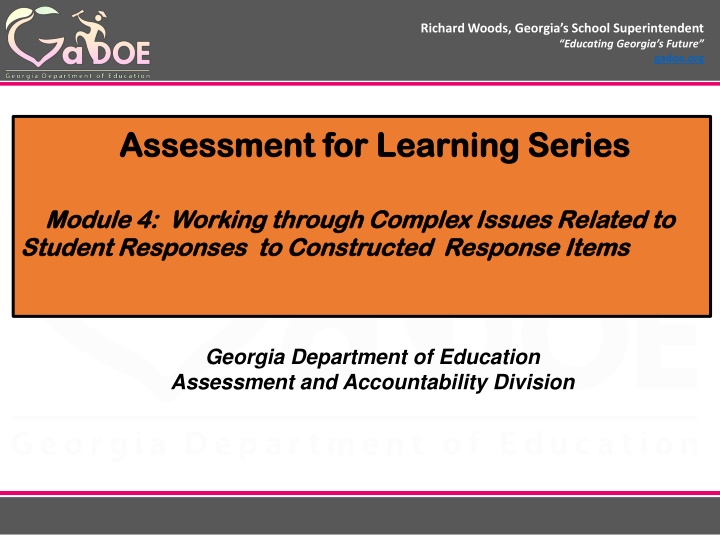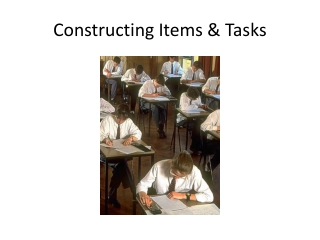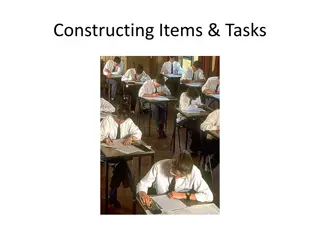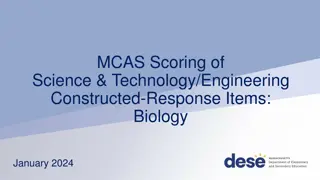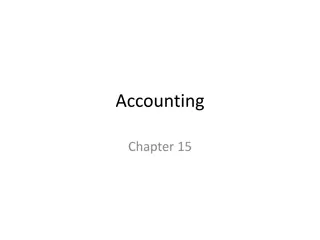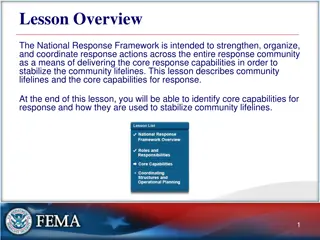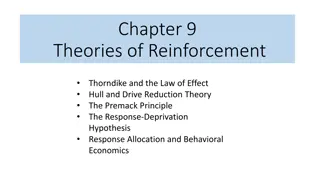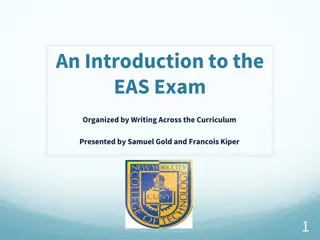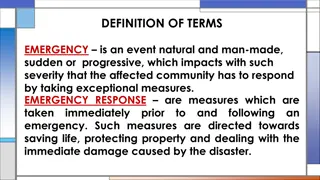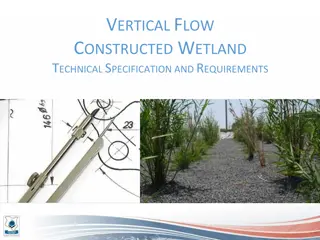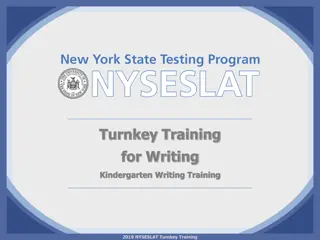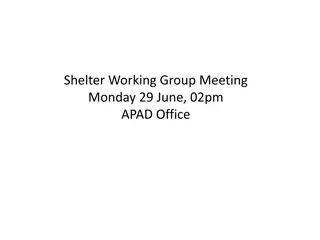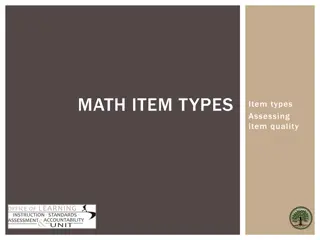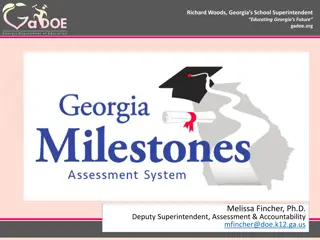Constructed Response Items in Education
Exploring the concept of constructed response items in education, this content delves into the complexities of student responses, assessment for learning, rubric development, and differentiation strategies. Richard Woods, Georgia's School Superintendent, provides insights on how to navigate through complex issues related to student responses on various subjects such as English Language Arts and Mathematics. The guidance offered includes creating rubrics, scoring student responses, and tailoring tasks to accommodate varying student abilities in a continuous assessment cycle for effective teaching and learning.
Download Presentation

Please find below an Image/Link to download the presentation.
The content on the website is provided AS IS for your information and personal use only. It may not be sold, licensed, or shared on other websites without obtaining consent from the author.If you encounter any issues during the download, it is possible that the publisher has removed the file from their server.
You are allowed to download the files provided on this website for personal or commercial use, subject to the condition that they are used lawfully. All files are the property of their respective owners.
The content on the website is provided AS IS for your information and personal use only. It may not be sold, licensed, or shared on other websites without obtaining consent from the author.
E N D
Presentation Transcript
Richard Woods, Georgias School Superintendent Educating Georgia s Future gadoe.org Assessment for Learning Series Assessment for Learning Series Module 4: Working through Complex Issues Related to Module 4: Working through Complex Issues Related to Student Responses to Constructed Response Items Student Responses to Constructed Response Items Georgia Department of Education Assessment and Accountability Division
Definition Definition Richard Woods, Richard Woods, Georgia s School Superintendent Educating Georgia s Future Educating Georgia s Future Georgia s School Superintendent gadoe.org gadoe.org Constructed response is a general term for items that require the student to generate a response as opposed to selecting a response. Constructed response items require more elaborate answers and explanations of reasoning. They allow for multiple correct answers and/or varying methods of arriving at the correct answer. Examples of skills required on constructed response tasks include, but are not limited to: English Language Arts Utilize close analytic reading Compare and contrast ideas and themes Synthesize ideas and concepts across a single or multiple texts Mathematics Apply mathematical procedures and skills to real world problems Express mathematical reasoning by showing work or explaining an answer
Using Assessment for Learning in Using Assessment for Learning in Classrooms: A Continuous Cycle Classrooms: A Continuous Cycle Richard Woods, Richard Woods, Georgia s School Superintendent Educating Georgia s Future Educating Georgia s Future Georgia s School Superintendent gadoe.org gadoe.org Assess Current Knowledge Create Lesson & Assessment Redesign and Teach Deconstruct Standard Provide Feedback Teach Assess Learning
Summary of Topics Summary of Topics Richard Woods, Richard Woods, Georgia s School Superintendent Educating Georgia s Future Educating Georgia s Future Georgia s School Superintendent gadoe.org gadoe.org How to develop rubrics for constructed response tasks How to score student responses for constructed response tasks How to differentiate constructed response tasks for varying student ability
How to Develop Rubrics for How to Develop Rubrics for Constructed Response Tasks Constructed Response Tasks Richard Woods, Richard Woods, Georgia s School Superintendent Educating Georgia s Future Educating Georgia s Future Georgia s School Superintendent gadoe.org gadoe.org Define the task which defines the learning standards being taught Identify the concepts or skills students need to demonstrate Determine the number of distinct performance levels for the task Identify the criteria for each level of performance
Richard Woods, Richard Woods, Georgia s School Superintendent Educating Georgia s Future Educating Georgia s Future Georgia s School Superintendent gadoe.org gadoe.org Grade 8 Math Example Grade 8 Math Example
Task Task Richard Woods, Richard Woods, Georgia s School Superintendent Educating Georgia s Future Educating Georgia s Future Georgia s School Superintendent gadoe.org gadoe.org While she was on vacation, Tara sent 14 friends either a letter or a postcard. She spent $3.84 on postage. If it costs $0.20 to mail a postcard and $0.33 to mail a letter, how many letters did Tara send? Show what you did to get your answer.
Skills to be Demonstrated Skills to be Demonstrated Richard Woods, Richard Woods, Georgia s School Superintendent Educating Georgia s Future Educating Georgia s Future Georgia s School Superintendent gadoe.org gadoe.org Build a function that models a relationship between two quantities. Develop a method to solve a system of two equations with two variables.
Number of Performance Levels Number of Performance Levels Identified Identified Richard Woods, Richard Woods, Georgia s School Superintendent Educating Georgia s Future Educating Georgia s Future Georgia s School Superintendent gadoe.org gadoe.org Interpretation of task processes Range of accuracy for processes Representation of task strategies and computations Accuracy of computations
Defined Performance Levels Defined Performance Levels Richard Woods, Richard Woods, Georgia s School Superintendent Educating Georgia s Future Educating Georgia s Future Georgia s School Superintendent gadoe.org gadoe.org Satisfactory Partial Minimal Unsatisfactory
Example of Example of Satisfactory Satisfactory Performance Level Response Performance Level Response Richard Woods, Richard Woods, Georgia s School Superintendent Educating Georgia s Future Educating Georgia s Future Georgia s School Superintendent gadoe.org gadoe.org
Example of Example of Partial Level Response Level Response Partial Performance Performance Richard Woods, Richard Woods, Georgia s School Superintendent Educating Georgia s Future Educating Georgia s Future Georgia s School Superintendent gadoe.org gadoe.org
Example of Example of Minimal Level Response Level Response Minimal Performance Performance Richard Woods, Richard Woods, Georgia s School Superintendent Educating Georgia s Future Educating Georgia s Future Georgia s School Superintendent gadoe.org gadoe.org
Exercise 1: Determine Performance Exercise 1: Determine Performance Level of Response Shown Level of Response Shown Richard Woods, Richard Woods, Georgia s School Superintendent Educating Georgia s Future Educating Georgia s Future Georgia s School Superintendent gadoe.org gadoe.org
Exercise 2: Determine Performance Exercise 2: Determine Performance Level of Response Shown Level of Response Shown Richard Woods, Richard Woods, Georgia s School Superintendent Educating Georgia s Future Educating Georgia s Future Georgia s School Superintendent gadoe.org gadoe.org
Richard Woods, Richard Woods, Georgia s School Superintendent Educating Georgia s Future Educating Georgia s Future Georgia s School Superintendent gadoe.org gadoe.org 8 8th th Grade Reading Example Grade Reading Example
Description of Passage Description of Passage Richard Woods, Richard Woods, Georgia s School Superintendent Educating Georgia s Future Educating Georgia s Future Georgia s School Superintendent gadoe.org gadoe.org The Alligator Poem describes an encounter with an alligator as the author leans down at a water source to take a drink. Detailed descriptions are given of the surroundings, the alligator s physical characteristics, and the drinker s response to the encounter.
Task Task Richard Woods, Richard Woods, Georgia s School Superintendent Educating Georgia s Future Educating Georgia s Future Georgia s School Superintendent gadoe.org gadoe.org Describe what happens to the speaker of the poem and explain what this experience makes the speaker realize.
Skills to be Demonstrated Skills to be Demonstrated Richard Woods, Richard Woods, Georgia s School Superintendent Educating Georgia s Future Educating Georgia s Future Georgia s School Superintendent gadoe.org gadoe.org Cite the textual evidence that most strongly supports an analysis of what the text says explicitly as well as inferences drawn from the text. Produce clear and coherent writing in which the development, organization and style are appropriate to the purpose of the task.
Number of Performance Levels Number of Performance Levels Identified Identified Richard Woods, Richard Woods, Georgia s School Superintendent Educating Georgia s Future Educating Georgia s Future Georgia s School Superintendent gadoe.org gadoe.org Number of parts requested in the task Range of responses for each part of the task Accuracy of responses for each part of the task
Definition of Definition of Satisfactory Satisfactory Performance Level Performance Level Richard Woods, Richard Woods, Georgia s School Superintendent Educating Georgia s Future Educating Georgia s Future Georgia s School Superintendent gadoe.org gadoe.org Responses at this level describe what happens to the speaker of the poem and explain what this experience makes the speaker realize.
Example of Example of Satisfactory Satisfactory Performance Level Response Performance Level Response Richard Woods, Richard Woods, Georgia s School Superintendent Educating Georgia s Future Educating Georgia s Future Georgia s School Superintendent gadoe.org gadoe.org The speaker was drinking some water from a lake when an alligator comes up with its mouth open ready to eat the speaker. The speaker falls to the ground and avoids the alligator. After that event, the speaker realizes how lucky he is to be alive. He looks around and see the nature s true beauty. How beautiful the birds and flowers are. How the water just ripples back to normal where the alligator just was.
Definition of Definition of Partial Level Level Partial Performance Performance Richard Woods, Richard Woods, Georgia s School Superintendent Educating Georgia s Future Educating Georgia s Future Georgia s School Superintendent gadoe.org gadoe.org Responses at this level describe what happens to the speaker of the poem, but the explanation of what this experience makes the speaker realize is general. Or, the explanation may simply repeat lines from the poem without interpreting them.
Example of Example of Partial Level Response Level Response Partial Performance Performance Richard Woods, Richard Woods, Georgia s School Superintendent Educating Georgia s Future Educating Georgia s Future Georgia s School Superintendent gadoe.org gadoe.org In the poem the speaker is nearly attacked by an alligator. This makes the speaker think of the world differently.
Definition of Definition of Minimal Level Level Minimal Performance Performance Richard Woods, Richard Woods, Georgia s School Superintendent Educating Georgia s Future Educating Georgia s Future Georgia s School Superintendent gadoe.org gadoe.org Responses at this level provide irrelevant details or personal opinions or may simply repeat the question.
Example of Example of Minimal Level Response Level Response Minimal Performance Performance Richard Woods, Richard Woods, Georgia s School Superintendent Educating Georgia s Future Educating Georgia s Future Georgia s School Superintendent gadoe.org gadoe.org The speaker was bird watching and an alligator crashed out of the water and onto land and the speaker was scared. After the alligator went back in the water all the birds flew out of the trees like a waterfall!!
Example of Example of Unacceptable Unacceptable Response Response Richard Woods, Richard Woods, Georgia s School Superintendent Educating Georgia s Future Educating Georgia s Future Georgia s School Superintendent gadoe.org gadoe.org The speaker didn t have anything happen to him. He was just having a dream, thinking it was real. But it wasn t.
How to Score Student Answers for How to Score Student Answers for Constructed Response Tasks Constructed Response Tasks Richard Woods, Richard Woods, Georgia s School Superintendent Educating Georgia s Future Educating Georgia s Future Georgia s School Superintendent gadoe.org gadoe.org Review, if available, an exemplary response Identify the key elements of an exemplary response Identify the quality of the key elements Match key elements and their characteristics to scoring rubric
How to Differentiate Constructed How to Differentiate Constructed Response Tasks for Varying Ability Response Tasks for Varying Ability Levels Levels Richard Woods, Richard Woods, Georgia s School Superintendent Educating Georgia s Future Educating Georgia s Future Georgia s School Superintendent gadoe.org gadoe.org Math Task Provide interpretation of task Suggest representations for strategies Simplified computations Reading Task Small parts of reading passage at one time Look for identified key elements in each reading portion Underline key vocabulary words and phrases
Close Close- -out out Richard Woods, Richard Woods, Georgia s School Superintendent Educating Georgia s Future Educating Georgia s Future Georgia s School Superintendent gadoe.org gadoe.org Constructed response items require students to construct an answer for the formative task and are scored based on criteria defined in rubrics. Constructed response items can be used formatively to learn how well students are progressing in mastery of standards. Student performance on constructed response items gives teachers information to adjust instruction and know if students are able to demonstrate complex thinking.
References References Richard Woods, Richard Woods, Georgia s School Superintendent Educating Georgia s Future Educating Georgia s Future Georgia s School Superintendent Ericsson, K. A., & et al., (1993). The role of deliberate practice in the acquisition of expert performance. Psychological Review, 100(3), 363-406. Georgia FIP Module 4: Analyzing evidence and providing effective feedback. www.gadoe.org/GeorgiaFIP Smarter Balanced Assessment Consortium General Item Specifications. (April 2012). Retrieved from: http://www.smarterbalanced.org/wordpress/wp- content/uploads/2012/05/TaskItemSpecifications/ItemSpecific ations/GeneralItemSpecifications.pdf Universal design for learning. Center for Applied Special Technology (CAST) http://www.cast.org/udl/index.html gadoe.org gadoe.org
